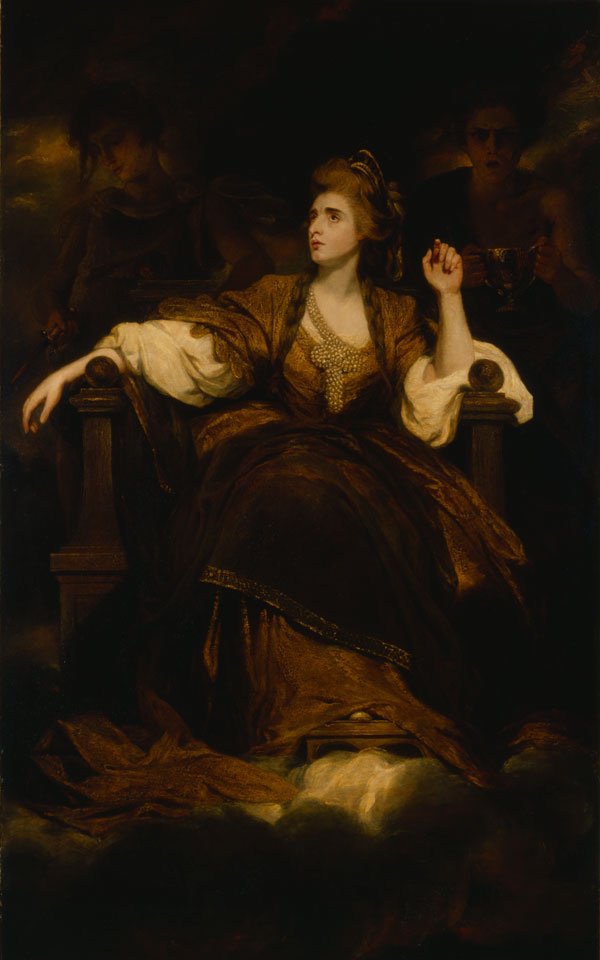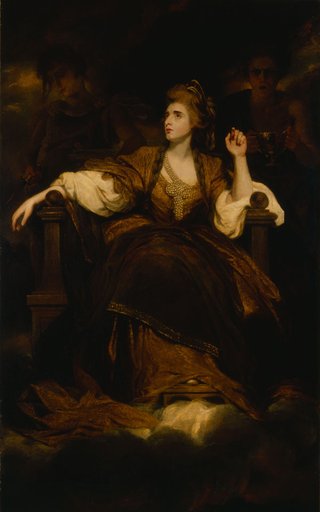

-
Acquisition
Bourgeois Bequest, 1811
-
Accession number
DPG318
-
Artist
Studio of Sir Joshua Reynolds
-
Date
1789
-
Dimensions
239.7 x 147.6 cm
-
Inscription
Signed and dated, on the edge of the drapery slung over her knees, lower centre: [JOSHVA] REYNOLDS PINXIT 1789
-
Materials
Oil on canvas
-
Notes
Conserved by the Getty Conservation Studio, Los Angeles, 1999
Monumental in scale and impact, the towering figure of the actor, Sarah Siddons (née Kemble; 1755–1831), commands the canvas. She appears spot-lit, seated on a throne borne aloft on clouds, dressed as the ancient Greek muse of tragedy, Melpomene. She wears a diadem in her hair and a chain of pearls, heavy around her neck. To reinforce her characterisation, she is flanked by allegories of Pity and Terror, whose faces loom from the dark background. Terror, on the right, holds a poisoned chalice while Pity, on the left, clutches a dagger in his hand. The orchestration of the composition culminates in Siddons’s dynamic pose with her head tilted and eyes looking upwards, her hand raised to indicate she is about to speak. Siddons claimed that she assumed the pose spontaneously, with her head turned to accentuate her well-known profile. A contemporary account gives a slightly different retelling; Siddons, having arrived late and a little flustered to Reynolds’s studio, was reported to have flounced to her seat and asked how Reynolds wanted her to pose. He allegedly replied, ‘just as you are’. That Siddons wished to take credit for the pose is testament to its effectiveness, and her desire to control her own image. Born Sarah Kemble, Siddons was the eldest of a theatrical family of actors, alongside her brothers John Kemble (1757–1823) and Charles Kemble (1775–1854). She carved her own path, becoming known as the Queen of Drury Lane for her mastery of tragic roles. She was the first woman to perform as Hamlet and brought a new interpretation to Lady Macbeth, with a nuance of maternity and fragility that was groundbreaking in Georgian theatre.
Sarah Siddons was painted many times but this portrait by the English artist Joshua Reynolds (1723–92) became an iconic image, described by the Regency artist Thomas Lawrence (1769–1830) as ‘indisputably the finest female portrait in the world’. This is a studio copy made a few years after the famed original, the popularity of which had solidified Siddons’s reputation and established Reynolds as an artist who had successfully combined the genres of portraiture and history painting, elevating him to near celebrity status himself. Reynolds kept the original painting for many years, putting a high price tag on it to reflect its already legendary standing. It was bought by Noël Desenfans (1745–1807), an art dealer and founder of Dulwich Picture Gallery, on behalf of a wealthy client, but kept in Desenfans’s private collection for some time. When the original was finally shipped to its owner, Desenfans commissioned this copy, in exchange for a painting by the Flemish artist Peter Paul Rubens (1577-1640). Although lacking the finesse of the original – Siddons herself remarked it was ‘a poor imitation’ – it still conveys the power of both sitter and artist, immortalised in a single image that defined them both.

Want to use or download this artwork?
For personal use - Download artwork
For commercial use - Purchase a licence & download on Bridgeman images